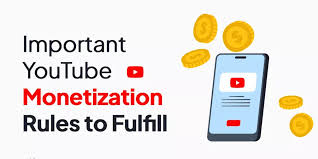
Understanding YouTube Monetization Policies: A Complete Guide for Creators (2025)
If you're a content creator looking to earn money from your videos, understanding YouTube's monetization policies is essential. As of 2025, YouTube continues to offer multiple ways to monetize content, but strict guidelines and eligibility requirements apply. Whether you're just starting or scaling your channel, this guide breaks down everything you need to know.
What Is YouTube Monetization?
YouTube monetization refers to earning money from your YouTube channel through ads, memberships, super chats, and other revenue streams. Once approved for the YouTube Partner Program (YPP), creators can enable ads on videos and access additional features to boost earnings.
Key Requirements for YouTube Monetization (2025)
To be eligible for the YouTube Partner Program, you must meet the following:
- 1,000 Subscribers
- 4,000 Public Watch Hours in the Last 12 Months or 10 Million Public YouTube Shorts Views in the Last 90 Days
- AdSense Account Linked to Your Channel
- No Active Community Guideline Strikes
- Follow All Monetization Policies and Guidelines
YouTube Monetization Methods
Once you're eligible, you can earn money through several features:
1. Ad Revenue
- Earn money when ads are shown on your videos.
- Ad formats include pre-roll, mid-roll, display, and bumper ads.
2. Channel Memberships
- Viewers can join your channel as members for monthly fees and get exclusive perks.
3. Super Chat & Super Stickers
- During live streams, viewers can pay to have their messages highlighted.
4. YouTube Premium Revenue
- You earn a share of the revenue when Premium members watch your content.
5. Merchandise Shelf
- Sell your branded merchandise directly below your videos.
6. Shorts Fund / Shorts Ads Revenue
- Earn from ads shown between Shorts in the feed. (Replaced the Shorts Fund in 2023)
YouTube Monetization Policies You Must Follow
YouTube is strict about how creators earn money. Violating any of these rules can lead to demonetization or even termination.
1. Ad-Friendly Content
- Content must be appropriate for advertisers.
- Avoid excessive profanity, violence, sexually suggestive content, and controversial topics.
2. Original Content
- Reused or non-transformative content may not be eligible.
- Compilation channels, unedited gameplays, or re-uploaded videos from other creators may be denied.
3. Copyright Compliance
- Use only content you own or have permission to use.
- Copyright strikes can lead to demonetization or bans.
4. Community Guidelines
- Avoid hate speech, harassment, misinformation, and harmful content.
5. Engagement Tactics
- Artificial inflation of views or subscribers using bots or clickbait is against the rules.
Common Reasons for Monetization Denial
- Reused content with little transformation
- Spammy or misleading metadata
- Repeated policy violations
- Content farms or low-quality videos
Tips to Stay Monetized and Grow Your Revenue
- Regularly review YouTube’s Monetization Policies
- Use copyright-free music and visuals
- Engage your audience authentically
- Post consistently and maintain video quality
- Read analytics to understand what works best
Final Thoughts
YouTube monetization is a powerful way to turn your passion into a profession. But it comes with responsibility. By creating original, high-quality content and respecting YouTube’s policies, you can build a sustainable and successful channel.
Ready to start monetizing your content? Make sure you meet the eligibility criteria and stay on top of policy updates—YouTube rewards creators who play by the rules.